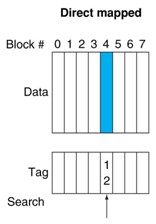There are many placement schemes for placing a block in the cache. The following figures show the location of a memory block whose address is 12 in a cache with eight blocks varies for (i) direct-mapped, (ii) set-associative, and (iii) fully associative placement.
- Set-Associative Cache
-
It is a cache that has a fixed number of locations (at least two) where each block can be placed. In a two-way set-associative cache, there would be four sets, and memory block 12 must be in set “ 12 modulo 4=0;” the memory block could be in either element of the set because(Block #) modulo (# of sets in cache)

|

|
|
“My soul is in the sky.” ― William Shakespeare, A Midsummer Night’s Dream |
